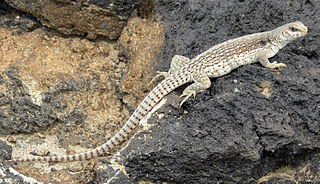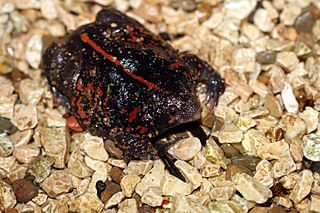Paroxysmal attacks or paroxysms are a sudden recurrence or intensification of symptoms, such as a spasm or seizure. These short, frequent symptoms can be observed in various clinical conditions. They are usually associated with multiple sclerosis or pertussis, but they may also be observed in other disorders such as encephalitis, head trauma, stroke, autism, asthma, trigeminal neuralgia, breath-holding spells, epilepsy, malaria, tabes dorsalis, and Behçet's disease, paroxysmal nocturnal hemoglobinuria (PNH). It has also been noted as a symptom of gratification disorder in children.

Tabes dorsalis is a late consequence of neurosyphilis, characterized by the slow degeneration of the neural tracts primarily in the dorsal root ganglia of the spinal cord. These patients have lancinating nerve root pain which is aggravated by coughing, and features of sensory ataxia with ocular involvement.

The desert iguana is an iguana species found in the Sonoran and Mojave Deserts of the Southwestern United States and northwestern Mexico, as well as on several Gulf of California islands.

The bay duiker, also known as the black-striped duiker and the black-backed duiker, is a forest-dwelling duiker native to western and southern Africa. It was first described by British zoologist John Edward Gray in 1846. Two subspecies are identified. The bay duiker is reddish-brown and has a moderate size. Both sexes reach 44–49 cm (17–19 in) at the shoulder. The sexes do not vary considerably in their weights, either; the typical weight range for this duiker is 18–23 kg (40–51 lb). Both sexes have a pair of spiky horns, measuring 5–8 cm (2.0–3.1 in). A notable feature of this duiker is the well-pronounced solid stripe of black extending from the back of the head to the tail.
In human anatomy, the dorsalis pedis artery is a blood vessel of the lower limb. It arises from the anterior tibial artery, and ends at the first intermetatarsal space. It carries oxygenated blood to the dorsal side of the foot. It is useful for taking a pulse. It is also at risk during anaesthesia of the deep peroneal nerve.

The Mexican burrowing toad is the single living representative of the family Rhinophrynidae. It is a unique species in its taxonomy and morphology, with special adaptations to assist them in digging burrows where they spend most of their time. These adaptations include a small pointed snout and face, keratinized structures and a lack of webbing on front limbs, and specialized tongue morphology to assist in feeding on ants and termites underground. The body is nearly equal in width and length. It is a dark brown to black color with a red-orange stripe on its back along with splotches of color on its body. The generic name Rhinophrynus means 'nose-toad', from rhino- (ῥῑνο-), the combining form of the Ancient Greek rhis and phrunē.

The American three-toed woodpecker is a medium-sized woodpecker, which is native to North America.

Glenealy is one of the few roads or streets without a suffix in Hong Kong. Located in the Mid-Levels on the Hong Kong Island, Hong Kong, it starts from Ice House Street and goes uphill to Hong Kong Zoological and Botanical Gardens, across Robinson Road and ends at Hornsey Road and Conduit Road.

The sharptooth smooth-hound is a houndshark of the family Triakidae. It is found on the continental shelves of the tropical eastern Pacific from southern Mexico to Peru between latitudes 20°N and 5°S. Its length is up to 64 cm.

The R752 road is a regional road in County Wicklow, Ireland. From its junction with the R772 in Rathnew on the outskirts of Wicklow Town it takes a generally south-westerly route to its junction with the R747 in the village of Woodenbridge, where it terminates. The road is 26 km (16 mi) long.

Glenealy is a village 8 km (5 mi) west of Wicklow Town, in County Wicklow, on the R752 road. The Dublin–Rosslare railway line also passes through the village.

The cliff chipmunk is a small, bushy-tailed squirrel that typically lives along cliff walls or boulder fields bordering Pinyon-juniper woodlands in the Western United States and Mexico. Cliff chipmunks are very agile, and can often be seen scaling steep cliff walls. Cliff chipmunks do not amass body fat as the more common ground squirrel does. They create caches of food which they frequent during the cold winter months.

The black-striped wallaby, also known as the scrub wallaby or eastern brush wallaby, is a medium-sized wallaby found in Australia, from Townsville in Queensland to Narrabri in New South Wales. In New South Wales, it is only found west of the Great Dividing Range. It is decreasing in these areas, but is not classified as threatened as a species yet. The New South Wales population, however, is classified as endangered.

The narrow-striped dasyure or narrow-striped marsupial shrew is a species of marsupial in the family Dasyuridae found in West Papua and Papua New Guinea. Its natural habitat is subtropical or tropical dry forests.

Thomas's broad-nosed bat is a species of bat in the family Phyllostomidae. It is found in Bolivia, Colombia, Ecuador, Panama, and Peru.

Scirtothrips dorsalis, the chilli thrips or yellow tea thrips, is an extremely successful invasive species of pest-thrips which has expanded rapidly from Asia over the last twenty years, and is gradually achieving a global distribution. It has most recently been reported in St. Vincent (2004) Florida (2005), Texas (2006), and Puerto Rico (2007). It is a pest of economic significance with a broad host range, with prominent pest reports on crops including pepper, eggplant, mango, citrus, strawberry, grapes, cotton, tea, peanuts, blueberry, and roses. Chilli thrips appear to feed preferentially on new growth, and infested plants usually develop characteristic wrinkled leaves, with distinctive brown scarring along the veins of leaves, the buds of flowers, and the calyx of fruit. Feeding damage can reduce the sale value of crops produced, and in sufficient numbers, kill plants already aggravated by environmental stress. This thrips has also been implicated in the transmission of three tospoviruses, but there is some controversy over its efficiency as a vector.
Glenealy Hurling Club is a Gaelic Athletic Association club located in the parish of Glenealy and Ashford in County Wicklow, Ireland. The club was founded in 1885 as a football club but switched codes to the game of hurling in the early 1920s.

Glenea is a genus of longhorn beetles belonging to the family Cerambycidae, subfamily Lamiinae.

Habroscelimorpha dorsalis, commonly known as the eastern beach tiger beetle, is a species of flashy tiger beetle in the family Cicindelidae. It is found in Central America and North America.















